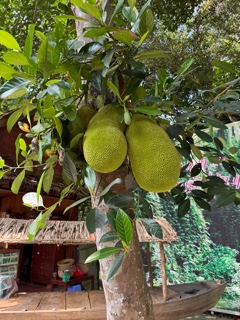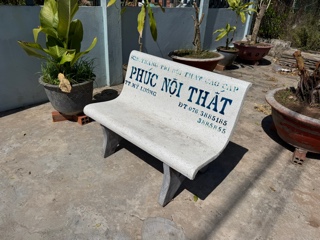Mekong Delta

Casamara
John & Susan Simpson
Fri 21 Feb 2025 12:11
| Back in May 2024 our friends from SV Che Figata, Zack and Jill, mentioned to us a cruise on the Mekong River they’d had recommended to them by a friend. We were all making plans to travel around SE Asia whilst waiting for the right moment to cross the Indian Ocean and we all agreed it would be a lot of fun to do the river cruise together. The boat would be a fully crewed river boat with just two double cabins so we would have the boat to ourselves, and the boat would be small enough to access the shallower waterways that the larger cruise ships couldn’t reach. Perfect! Fast forward to early February 2025 and we were rushing on a fast ferry down the Mekong River from Phnom Penh in Cambodia to the border with Vietnam at Tan Chau. It was a six hour ferry ride on a hot, bumpy speedboat (not our cruise boat!) filled to the gunnels with 30+ passengers, which took us all a bit by surprise as the tour itinerary had skimmed over that little detail. As well as the long journey, we also had two border control points to negotiate with the help of our ferry captain, who insisted on gathering all our passports together and taking them to the offices himself, and then handing them out one by one for us to get our individual passports stamped. It was all a bit of a bunfight as he shouted out the names of the 30 passengers in a heavy Vietnamese accent, not helped by the fact that he only used our first and middle names and rushed about whilst shouting. Picture him running away holding out my passport shouting "Soosaan Jaaaanne, Soosaan Jaaaane” and me running after him shouting “me, me, me, that’s mine, I’m here!”, trying desperately to get my passport back before he gave up and moved on to the next one. All a bit stressful! Things got a lot better once we’d cleared the Vietnamese border and the fast ferry glided expertly up to our new home for the week, the river boat ‘Dragon Eyes’. We felt very relieved to be on board as we waved farewell to our fellow ferry passengers, who still had an hour left before they would be dropped off further downstream. We were introduced to our English-speaking guide, whose name we thought was Why but later discovered was Hoy….or at least we think so. He answered to any combination of those sounds. We also had a captain, a first mate, a cook and a barman. Sheer luxury for us yachties used to doing all those jobs ourselves.  ‘Dragon Eyes’  The top deck had sun loungers, and beyond is the dining table and bar area  Our cabin The Mekong Delta is a vast network of rivers, canals, swamps and trenches occupying 17,000 square miles in the south west of Vietnam. It is low-lying and the volume of water fluctuates with the seasons. Whilst it is very fertile, the area is also susceptible to flooding with rising sea levels. During our visit the water levels were low but the height of buildings built on stilts at the waters edge showed just how much the water level would rise during the rainy season.  Riverside buildings on stilts Getting on and off the boat was a bit of an art. Our captain would stick the boat’s nose or stern into the bank, or sidle up to another vessel as close as they could get to the shore, and they would haul out the gangplank to put us ashore. Lucky we’re used to jumping on and off boats! Our days settled into a pattern of breakfast at 8 am, onshore excursion, lunch at 1 pm, watching the world go by as the boat moved to its next destination, drinks before dinner at 7 pm, early to bed. We had more hours sleep than we’ve had in a long time!  One of the gangplank arrangements Land in the Mekong Delta region is used for growing nearly half of Vietnam’s cereal crops, the majority being rice. The food served on board Dragon Eyes was very good and based on the key ingredients grown locally: rice (lots of it and in various guises), lemongrass, carrots, mushrooms, onions, chillies, garlic, beetroot, herbs, tomatoes, dragon fruit, jackfruit, guava, longan, passion fruit, pomelo, mango, coconut, water apple, ladies finger bananas, and more. Each meal was 3 or 4 light courses and all of it delicious. Sometimes it was served in an unpredictable order, so we might have soup first followed by a salad course, a meat or fish course and ending with fruit. Or we might get the meat first, then salad, then soup, etc. We got into the habit of asking at the beginning of the meal what to expect in order to pace ourselves appropriately. We enjoyed trips to the local markets to see the fresh food and flowers on sale. The quality of the produce was really good, and much better than we had seen in Indonesia. We were also taken to various places where local delicacies were produced, from rice paper and rice noodles, to snake wine and Kopi Luwak (civet coffee). We didn’t believe our guide at first when he said that the coffee is made by collecting partially digested coffee beans from animal poo, but apparently it’s true! We declined the opportunity to try some but John did take a small glass of snake wine - made by pickling a (dead) snake in alcohol. He said it tasted like chicken. Mmmmm, tasty…I don’t think!  People go to the market by scooter and drive up to the stalls to buy goods without getting off the bike. Here’s someone choosing fish from the floor before making his purchase.  Beautiful chrysanthemums are everywhere. They symbolise luck, prosperity and longevity in Vietnamese culture.  We saw these barges frequently and initially thought they carried sand as we’d also seen dredgers, but later found out that the cargo is rice.  Jackfruit, and their more prickly, smelly cousins the Durian fruit, grow to a huge size. The flesh is quite stringy and yellow inside, and surprisingly tasty. It can also be used as a meat substitute in vegan dishes. According to Hoi, when Vietnamese children have been naughty, being made to kneel on a Jackfruit or Durian for a while is their version of the naughty step! On our shore excursions we came across a number of brightly coloured, twin towered temples, often with a single eye painted in the centre of the building’s front and above the altar. These are places of worship for followers of the Vietnamese religion, Cao Dai, which was founded in 1926 and combines practices from Confucianism, Taoism, Buddhism and Roman Catholicism. Beliefs centre around the concept of a single God, represented by the divine eye, and striving for peace and unity amongst all religions. With around 5 million followers, Cao Dai is the third largest religious group in Vietnam.  Cao Dai Temple, Tan Chau, Vietnam  The brightly coloured altar front carries symbols from a number of religions, note Jesus in the foreground along with two large herons We noticed that there were scores of concrete benches wherever we went, all with words printed on them. Thinking they might be memorial benches, we asked our guide what their purpose was. He explained that when someone orders a large delivery of sand, gravel or building materials, a bench comes with the order bearing the name of the supplier so that the buyer knows the name and number of the supplier should they need to order more. A bit like a business card, only more cumbersome!  A ‘business card’ bench In Sa Dec we visited the Huynh Thuy Le ancient house. Built in 1885, ancient is a relative term but in an area where the natural environment is very harsh, a building surviving 150 years is very old. It was the home of a prosperous Chinese-Vietnamese trader whose son had a a love affair with a much younger French girl living nearby, Marguerite Duras. Years later she wrote a semi-autobiographical novel about the affair and the story was made into a film called “L’Amant” in 1992. The lady who showed us the house told us that the film is currently banned in Vietnam. Originally it was only going to be censored but by the time all the saucy parts had been edited out the 115 minutes running time had reduced to only 20 minutes and it was decided to ban it altogether. Our guide said she’d seen the film twice and as a result had two children, so she’d told her husband they weren’t going to watch it again!  Huynh Thuy Le Ancient House combines Chinese, Vietnamese and French influences, reflecting the history of Vietnam A number of times we decamped from the boat to be ferried around the smaller canals in sampans. These long, skinny boats have a platform at the back where the helmsman (usually a lady) sculls the boat with oars or uses one of the long tail engines (basically a lawn mower or small car engine balanced on a huge pole with a propellor at one end - direct drive - so no gearbox - to keep it simple) One of the most atmospheric of these outings was to Xeo Quyt where the Vietcong were based in the Mekong Delta during the Vietnam war. From our sampan we got a good idea of just how difficult it must have been for American troops to make any headway in the swampy jungle. The tunnels and bunkers where the Vietcong hid would have been impossible to see until too late.  One of our lovely sampan drivers The week on board Dragon Eyes passed by in a flash, there was so much to see and learn about. It was certainly a memorable experience. We will return to Vietnam in a few weeks, visiting the cities on the coast further north, but first we head back to Thailand for a couple of weeks in Phuket. |